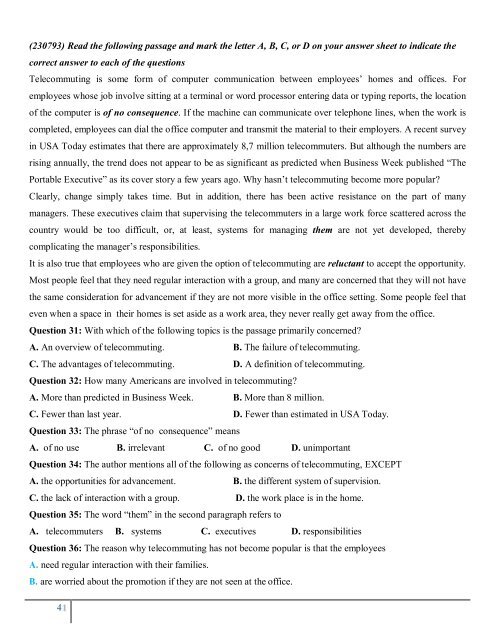12 đề thi thử THPT Quốc gia môn tiếng Anh năm 2018 có lời giải chi tiết
https://app.box.com/s/nnfa5e7e8wjt4ogw5c12nscparzxshyv
https://app.box.com/s/nnfa5e7e8wjt4ogw5c12nscparzxshyv
Create successful ePaper yourself
Turn your PDF publications into a flip-book with our unique Google optimized e-Paper software.
(230793) Read the following passage and mark the letter A, B, C, or D on your answer sheet to indicate the<br />
correct answer to each of the questions<br />
Telecommuting is some form of computer communication between employees’ homes and offices. For<br />
employees whose job involve sitting at a terminal or word processor entering data or typing reports, the location<br />
of the computer is of no consequence. If the ma<strong>chi</strong>ne can communicate over telephone lines, when the work is<br />
completed, employees can dial the office computer and transmit the material to their employers. A recent survey<br />
in USA Today estimates that there are approximately 8,7 million telecommuters. But although the numbers are<br />
rising annually, the trend does not appear to be as significant as predicted when Business Week published “The<br />
Portable Executive” as its cover story a few years ago. Why hasn’t telecommuting become more popular?<br />
Clearly, change simply takes time. But in addition, there has been active resistance on the part of many<br />
managers. These executives claim that supervising the telecommuters in a large work force scattered across the<br />
country would be too difficult, or, at least, systems for managing them are not yet developed, thereby<br />
complicating the manager’s responsibilities.<br />
It is also true that employees who are given the option of telecommuting are reluctant to accept the opportunity.<br />
Most people feel that they need regular interaction with a group, and many are concerned that they will not have<br />
the same consideration for advancement if they are not more visible in the office setting. Some people feel that<br />
even when a space in their homes is set aside as a work area, they never really get away from the office.<br />
Question 31: With which of the following topics is the passage primarily concerned?<br />
A. An overview of telecommuting. B. The failure of telecommuting.<br />
C. The advantages of telecommuting. D. A definition of telecommuting.<br />
Question 32: How many Americans are involved in telecommuting?<br />
A. More than predicted in Business Week. B. More than 8 million.<br />
C. Fewer than last year. D. Fewer than estimated in USA Today.<br />
Question 33: The phrase “of no consequence” means<br />
A. of no use B. irrelevant C. of no good D. unimportant<br />
Question 34: The author mentions all of the following as concerns of telecommuting, EXCEPT<br />
A. the opportunities for advancement. B. the different system of supervision.<br />
C. the lack of interaction with a group. D. the work place is in the home.<br />
Question 35: The word “them” in the second paragraph refers to<br />
A. telecommuters B. systems C. executives D. responsibilities<br />
Question 36: The reason why telecommuting has not become popular is that the employees<br />
A. need regular interaction with their families.<br />
B. are worried about the promotion if they are not seen at the office.<br />
4

















